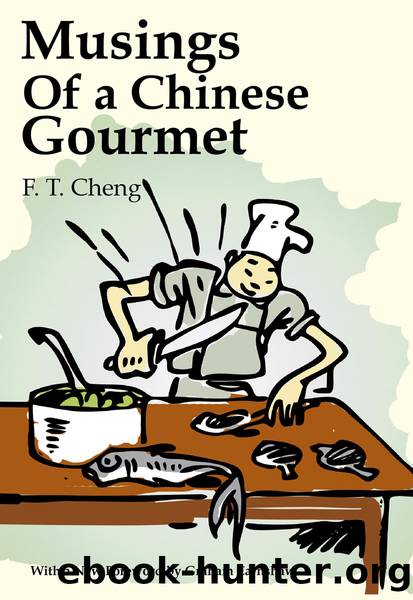Musings of a Chinese Gourmet by F. T. Cheng

Author:F. T. Cheng
Language: eng
Format: epub
Publisher: Earnshaw Books
Published: 2008-08-14T16:00:00+00:00
5. ABALONE (BOW YU).
It is produced in Kowloon, Hong Kong, Mexico, some parts of America, Japan, and probably other places too. But the best comes from Japan, because it is more tasty and more tender than others. The Japanese generally eat it raw and sell the dried one to the Chinese, who so relish it as a delicacy that the average man almost forgets that it comes from abroad. It is rich in nutrition, particularly when dried. In 100 grammes it contains:1
1 Calories 309
2 Protein 40.6 gm.
3 Fat 1.9 gm.
4 Carbohydrate 28.8 gm.
5 Calcium 170 mg.
6 Phosphorus 442 mg.
7 Iron 7.1 mg. (imputed value)
8 Thiamine .41 mg.
9 Riboflavin .37 mg.
10 Niacin value 3.6 mg. (imputed)
(a) Half a pound of this will be sufficient for a dish for 10-12 persons. Clean it thoroughly with warm water and then soak it in cold water for four days, changing the water twice a day. After this, clean it again. By this time it is well softened and much enlarged.
(b) Put it in a double saucepan (preferably an earthenware one) with about four tablespoonfuls of hot water, some chicken fat or a few slices of fat pork, a dessertspoonful of peanut oil, and a glass of wine like sherry. Then cook it for five hours over a medium fire. If during the process of cooking it has absorbed all the water and wine and consequently gets dry, add a dessertspoonful of hot water each time.
(c) Then it will be quite tender. Add no salt, unless necessary, or anything else, because the abalone itself is as a rule salty enough. All that remains to be done is to slice it into pieces and serve it with the little juice that is there.
N.B.—After it has been cut into slices, it must not be cooked again, otherwise it will get hardened. Abalone prepared in this way tastes at its best, because its original flavour is preserved 100%. To season the abalone with oyster sauce, as most Cantonese restaurants do, is not the best way of preparing this dish; because the taste of the abalone, which is delicious and unique, would thus be overshadowed by the oyster sauce, which has a predominant taste. Some people, not knowing how to soften the abalone in the right way, would even cook it with a little sodium bicarbonate. This should not be done, for the fine flavour of the abalone would thus be ruined, if not destroyed. The abalone here is assumed to be of good quality. Those of poor quality cannot be made very tender.
Download
This site does not store any files on its server. We only index and link to content provided by other sites. Please contact the content providers to delete copyright contents if any and email us, we'll remove relevant links or contents immediately.
| Africa | Americas |
| Arctic & Antarctica | Asia |
| Australia & Oceania | Europe |
| Middle East | Russia |
| United States | World |
| Ancient Civilizations | Military |
| Historical Study & Educational Resources |
Wabi sabi by Kempton Beth(720)
Mr. Selden's Map of China by Timothy Brook(600)
Heroic Hindu Resistance To Muslim Invaders (636 AD to 1206 AD) by Sita Ram Goel(572)
Akbar: The Great Mughal by Ira Mukhoty(541)
The Meaning of India by Raja Rao(536)
Vedic Physics: Scientific Origin of Hinduism by Raja Ram Mohan Roy(533)
Banaras by Diana L. Eck(525)
Philippines--Culture Smart! by Culture Smart!(502)
Mao's Great Famine: The History of China's Most Devastating Catastrophe, 1958-1962 by Frank Dikötter(500)
Food of India by unknow(494)
China Unbound by Joanna Chiu(485)
How to Be a Modern Samurai by Antony Cummins(473)
India--Culture Smart! by Becky Stephen(471)
A History of Japan by R.H.P. Mason & J.G. Caiger(466)
Insurgency and Counterinsurgency by Jeremy Black(463)
North of South by Shiva Naipaul(459)
The Genius of China: 3,000 Years of Science, Discovery, and Invention by Robert Temple(445)
Kim Jong Un and the Bomb by Ankit Panda(428)
The Digital Silk Road by Jonathan E. Hillman(422)
